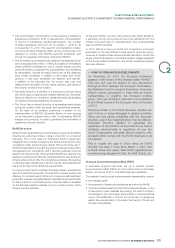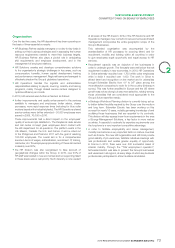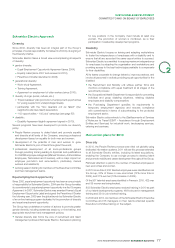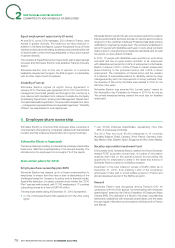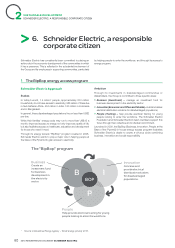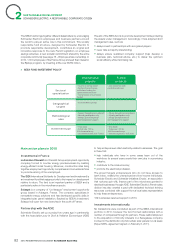APC 2010 Annual Report Download - page 79
Download and view the complete annual report
Please find page 79 of the 2010 APC annual report below. You can navigate through the pages in the report by either clicking on the pages listed below, or by using the keyword search tool below to find specific information within the annual report.
SUSTAINABLE DEVELOPMENT
COMMITTED TO AND ON BEHALF OFEMPLOYEES
Schneider Electric Approach
Diversity
Since 2002, diversity has been an integral part of the Group’s
principles of social responsibility, formalised in 2004 by its signing of
the Diversity Charter.
Schneider Electric takes a broad view encompassing all aspects
of diversity:
•gender diversity:
–Equal Employment Opportunity Agreement (since 2004),
–Equality Label (since 2007 and renewed in 2010),
–Parenthood Charter (launched in 2008);
•generational diversity:
–Work-study Agreement,
–Training Agreement,
–Agreement on employment of older workers (since 2010);
•diversity of origin (social, cultural, etc.):
–“Espoir banlieue” plan (promotion of employment opportunities
for young people from underprivileged areas),
–partnership with the “Nos Quartiers ont du Talent” (Our
neighborhoods have talent) association,
–“100 opportunities – 100 jobs” campaign (see page 87);
•disability:
–Disability Agreement (eighthagreement signed in 2010).
Several programs have been developed to promote our diversity
policy:
•People Review process to detect talent and promote equality
and diversity at all levels of the Company, ensuring professional
development based on equality for both men and women;
•development of the potential of men and women to grow
Schneider Electric’s pool of talent throughout the world;
•professional development of all socio-professional groups
through providing training leading to diplomas and qualifi cations
for OATAM employee categories (Manual Workers, Administrative
Employees, Technicians and Foremen), with a major impact on
employee promotion and remuneration, particularly manual
workers and assistants;
•working session training for members of the Executive Committee
and their management teams.
Equal employment opportunity
Since 2002, equal employment opportunity has been a core principle
of responsibility for Schneider Electric. 2004 saw the Group formalise
its commitments to equal employment opportunity in a fi rst Company
Agreement. In 2007, Schneider Electric was awarded France’s Equal
Employment Opportunity Label and signed the Parenthood Charter
the following year. 2009 saw the global launch by Schneider Electric
of an on-line training program dedicated to the promotion of diversity
and equal employment opportunity.
The Group has undertaken a number of actions to promote greater
gender diversity, including awareness sessions, on-line training, and
appropriate recruitment and management policies.
•Gender diversity also forms the core of recruitment and talent
management policies at Schneider Electric. Succession planning
for key positions in the Company must include at least one
woman. The promotion of women is monitored, as is their
participation in leadership development programs.
Disability
Schneider Electric focuses on training and adapting workstations
to foster the independence of employees with a disability and to
ensure that all are accorded the same opportunities to succeed.
Schneider Electric is committed to ensuring maximum independence
for employees by adapting the organisation and workstations and
providing access to the best technologies available to compensate
for their disabilities.
All its teams cooperate to change behavior, improve practices, and
involve all personnel in actively providing equal opportunities for the
disabled:
•the Recruitment and Mobility unit utilises partner fi rms and
monitors compliance with equal treatment at all stages of the
recruitment process;
•the Occupational Health Department is responsible for preventing
individual and group disabling situations, retaining disabled
employees and disability compensation;
•the Purchasing Department specifi es its requirements to
temporary employment agencies and ensures compliance
with commitments in terms of subcontracting to the protected
employment sector.
Schneider Electric subcontracts to the Établissements et Services
d’Aides par le Travail (ESAT – Assistance through Employment
Entities and Services) for industrial work, landscaping services,
catering and seminars.
Main action plans for 2010
Diversity
In 2010, the People Review process was rolled out globally using
dedicated information systems. 2011 will see this process extended
to all Schneider Electric entities, including its latest acquisitions,
enabling the Company to use a single process to develop talent
and promote mobility and career development throughout the Group.
Particular attention is paid to the number of talented employees in
new economies and women.
In 2010 more than 2,200 talented employees were identifi ed across
the Group, 30% of these in new economies (12% more than in
2009), and 21% women (10% increase on 2009).
Of the 507 talented employees identifi ed in France in 2010, 422 men
and 85 women are being tracked.
803 Schneider Electric employees received training in 2010 as part
of our talent development programs; 469 took part in management
training and 334 in job-oriented training.
In 2009 and 2010, six members of the Schneider Electric Executive
Committee and 68 managers on their teams attended specifi c
Executive Committee training on the subject.
2010 REGISTRATION DOCUMENT SCHNEIDER ELECTRIC 77
2




